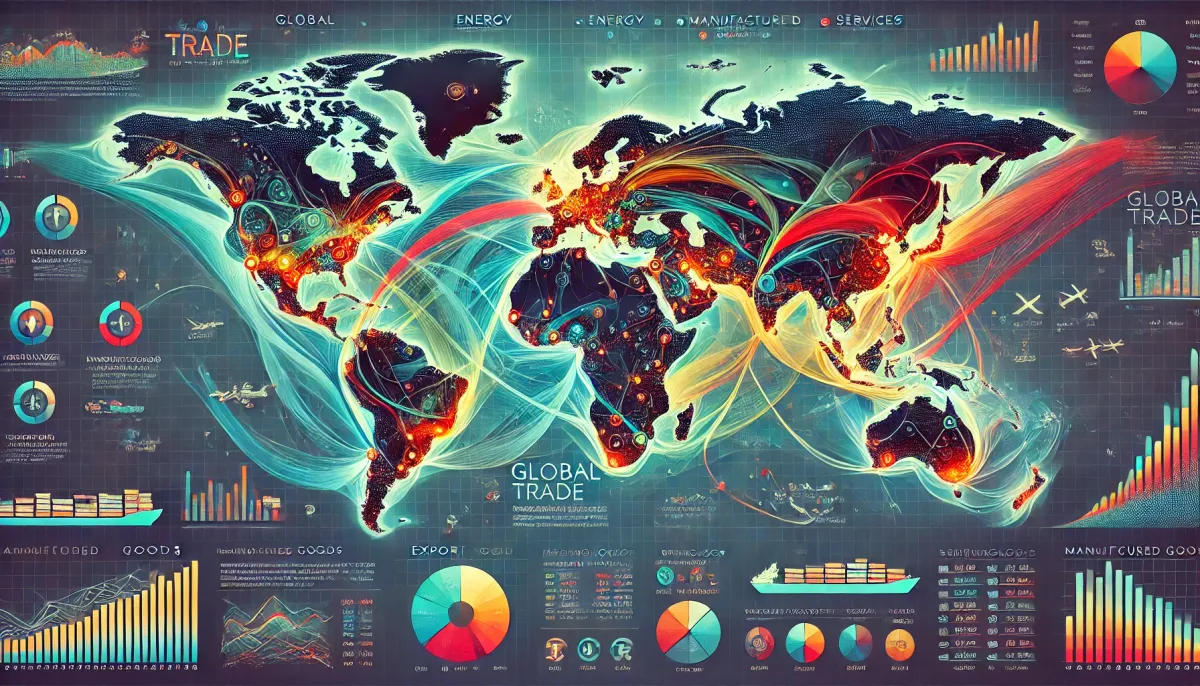Global Economic Shifts

The Great Economic Realignment: How Treasury Markets and Trade Wars Signal a New Global Order
In the complex dance of global economics, seemingly disparate movements often reveal deeper patterns of change. As we examine the events of 2024, a profound transformation in the international economic order becomes apparent, marked by shifting financial allegiances, technological competition, and the reimagining of global supply chains.
Financial Decoupling: The process by which major economic powers reduce their financial interdependence, often starting with the unwinding of sovereign debt holdings.
Example: Japan and China's historic treasury sell off represents the largest coordinated reduction in US debt holdings in modern history.
The Treasury Exodus: Canary in the Economic Coal Mine
The third quarter of 2024 witnessed an unprecedented shift in the global financial landscape. Japan and China, long the stalwart holders of US government debt, orchestrated a massive selloff totaling $13 billion in treasuries. This wasn't merely a routine portfolio adjustment – Japan's sale of $61.9 billion in US securities marked the largest such move in recorded history, while China's $51.3 billion reduction represented their second-largest selloff ever.
These movements, occurring just before the US presidential election, sent tremors through the financial markets. Treasury yields surged to a 2.5-year high in mid-September, followed by a sharp 4% drop in value after the election results. Yet these dramatic moves tell only part of the story.
Market Scale Context: The US Treasury market, valued at $26.5 trillion, represents 42% of the Bloomberg Aggregate Bond Index, making it the world's largest and most liquid bond market.
The scale of these holdings remains staggering even after the reductions: Japan maintains $1.02 trillion in treasuries, while China holds $731 billion. However, the trajectory is clear – China's holdings have plummeted 44% from their November 2013 peak of $1.3167 trillion, signaling a systematic withdrawal from dollar-denominated assets.
The Technology Race: A New Cold War
As financial ties loosen, technological competition intensifies. The conventional wisdom that China lagged 8-10 years behind the US in semiconductor technology was shattered by recent developments. Analysis of Chinese-made smartphones, particularly the Mate 60, revealed semiconductor capabilities just 4-5 years behind current US technology – a gap closing faster than many thought possible.
Technological Leapfrogging: The process by which developing nations bypass intermediate stages of technology development, sometimes achieving parity in advanced sectors while still developing in others.
This technological advancement hasn't gone unnoticed. The US response has been swift and comprehensive, implementing restrictions on high-tech exports and semiconductor sales. However, these measures may have accelerated China's push for self-reliance, spurring domestic R&D and scientific capability development.
The Manufacturing Chess Game
Perhaps the most fascinating development is the strategic reorganization of global manufacturing. Chinese companies have executed a sophisticated response to trade pressures, exemplified by their investment in Mexico. In 2023, Chinese foreign direct investment in Mexico reached $3.7 billion, with the Husan Industrial Park near Monterrey emerging as a microcosm of this shift. Within three years, this facility has become home to 30 Chinese firms, including nine major automotive companies.
This strategic repositioning represents a masterclass in regulatory arbitrage – using regional trade agreements to maintain market access while navigating geopolitical tensions.
The European theatre presents another front in this economic competition. Chinese electric vehicles captured 19.5% of European EV sales in 2023, projected to reach 25% by 2024. The EU's response – a graduated tariff system ranging from 17.0% for BYD to 35.3% for SAIC – demonstrates the delicate balance between protecting domestic industries and maintaining trade relationships.
Implications and Future Trajectories
The interconnected nature of these developments reveals a larger pattern: the emergence of a multipolar economic order characterized by:
- Regional Manufacturing Hubs: The rise of strategic manufacturing centers like Mexico's Husan Industrial Park
- Technological Independence: Accelerated development of domestic capabilities in critical sectors
- Financial Realignment: Reduced dependency on traditional financial instruments like US treasuries
The German auto industry serves as a canary for these changes. With four major factories in the US and 8,000 employees affected by trade tensions, the 37% drop in exports to China signals the real-world impact of these shifts. The cancellation of Volt Energy Technology's European operations and €3.87 billion battery factory plans further illustrates the cascading effects of these economic realignments.
Looking Forward
These developments suggest we're witnessing not just a series of trade disputes, but a fundamental reorganization of the global economic order. The combination of financial decoupling, technological competition, and manufacturing redistribution points to a future characterized by:
- More regionalized supply chains
- Increased emphasis on technological self-sufficiency
- Complex networks of trade relationships replacing simple bilateral dependencies
As we move forward, the ability to navigate this new landscape will depend on understanding these interconnected patterns and their implications for global economic stability and growth.
Treasury Market Developments
Record-Breaking Sales
In the third quarter of 2024, Japan and China orchestrated an unprecedented selloff of US government debt, with combined disposals reaching $13 billion. Japanese investors set a historical record by selling $61.9 billion in US securities, while Chinese funds disposed of $51.3 billion during the same period, marking their second-largest selloff on record.
Current Holdings
Despite these significant reductions:
- Japan maintains ownership of $1.02 trillion in treasuries
- China holds $731 billion in US government debt
- China's holdings have decreased by 44% since reaching their peak of $1.3167 trillion in November 2013
Market Scale
The US Treasury market, valued at $26.5 trillion, represents the world's largest and most liquid bond market, accounting for over 42% of the Bloomberg Aggregate Bond Index.
Currency Market Interventions
On July 11th and 12th, Japan's Ministry of Finance executed a massive currency market intervention:
- Total intervention: 5.53 trillion yen (approximately $35.9 billion)
- Purpose: Selling dollars to buy yen
- Impact: Significantly influenced their treasury holding decisions
Trade and Manufacturing Shifts
Chinese Investment in Mexico
- Foreign direct investment from China in Mexico reached $3.7 billion in 2023
- The Husan Industrial Park, 25 miles north of Monterrey, hosts:
- At least 30 Chinese firms
- Nine Chinese car companies, including BYD and Chery
- Significant manufacturing operations established in the past three years
European Market Developments
- Chinese electric vehicles represented 19.5% of EV sales in Europe in 2023
- Projected to reach 25% by 2024
- EU's anti-subsidy tax plan implemented varying tariff rates:
- BYD: 17.0%
- GLE: 18.8%
- SAIC: 35.3%
- Other manufacturers: 20.7%
Trade Processing
- The Isleta Crossing, second only to Laredo, Texas, in Mexico-US trade volume
- Average processing time: Less than 30 minutes for US Customs clearance
Technology and Manufacturing Competition
Semiconductor Development
Recent analysis of Chinese semiconductor capabilities reveals:
- Technological gap with the US reduced to 4-5 years, down from previous estimates of 8-10 years
- Significant advancement demonstrated in the Mate 60 smartphone
- Increased focus on domestic R&D and scientific capabilities
Export Control Measures
The US has implemented various restrictions:
- Expanded entity list limiting exports to Chinese companies
- Controls on high-tech exports to China and its allies
- Restrictions on advanced semiconductor sales
International Trade Dynamics
Chinese Export Performance
- October 2024 showed the fastest export growth in over two years at 12.7% year-on-year
- Exports to the US increased by 88.1% annually
- European shipments rose by 12.7% in the same period
US-China Trade Relations
- Proposed tariffs of over 60% on Chinese imports
- UBS analysis suggests such tariffs could reduce China's economic growth by 2.5 percentage points
- Potential impact on various sectors, particularly electric vehicles and semiconductors
European Market Response
German Auto Industry Impact
- Four large car factories in the United States
- 8,000 employees affected
- 37% drop in exports of German cars from the US to China
- Volt Energy Technology announced termination of European operations effective January 31st, 2025
- Canceled plans for two battery factories worth €3.87 billion
Market Adaptation Strategies
Manufacturing Relocation
- Increased container traffic from China to Mexico
- Highest volumes of Mexico exports to US recorded from April to June 2024
- Strategic shift from finished goods to raw materials and component parts
Policy Response
Ten EU countries, including France and Poland, supported maximum tariffs of 35.3% on Chinese goods, while:
- Five countries, including Germany, opposed
- Twelve member states abstained
- Original tariff rate was 10%
Future Implications
The evolving situation presents several critical challenges:
- Potential increases in consumer prices for imported goods
- Restructuring of global supply chains
- Shift in international trade patterns
- Growing emphasis on regional manufacturing hubs
- Development of alternative financial systems
These developments represent a fundamental reshaping of global economic relations, with implications for international trade, financial markets, and technological development. The continued evolution of these trends will likely influence economic policy and international relations for years to come.
